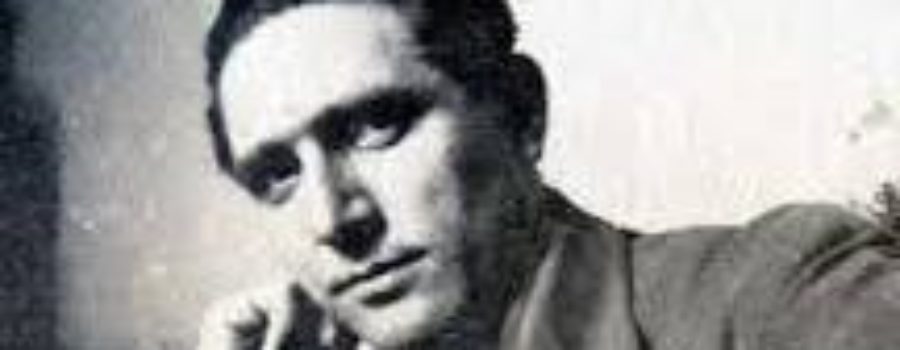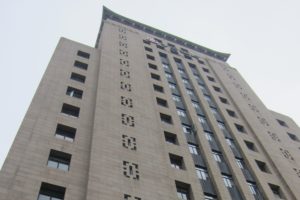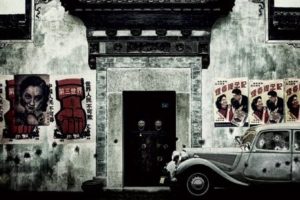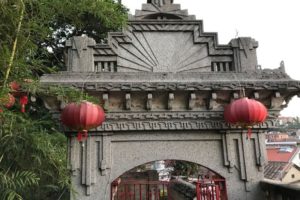This Sunday, we’ll explore the Art Deco buildings designed by Alexandre Léonard, one of Shanghai’s most talented architects, and finish up with a special treat: a visit to the penthouse apartment where he lived–and from which he disappeared, without a trace. Will we solve the mystery of his disappearance? Come along and find out!
You can’t talk about Art Deco in Shanghai without talking about the immensely talented Alexandre Léonard. One of the city’s leading French architects during the Art Deco age, Leonard designed villas, apartment houses, and civic buildings that would become landmarks of the former French Concession and define the Shanghai Art Deco style.
And then, at the end of World War II, he vanished. The mystery of his disappearance has never been solved, but his presence remains on the streets of Shanghai in the beautiful Art Deco architecture he left us.
Leonard – The Early Years
Born in Paris in 1890, the young Leonard had a passion for design, and so in 1908, he entered the École des Beaux Arts. Renowned as Europe’s finest school of art and architecture, the training was grounded in the classical arts and architecture of ancient Greece and Rome and the curriculum was divided between architecture and painting & sculpture.
It was a turbulent time in Europe, and Léonard’s education was interrupted by the Great War: in 1914, he was drafted and sent to fight in Flanders, one of the major battle fronts of the war. Léonard was wounded several times, and received the Croix de Guerre, the military decoration that rewards feats of bravery.


With the end of the war in 1918, Léonard returned to school, receiving his diploma in 1919 – just as the modernizations that would eventually lead to the Art Deco movement were taking hold. Meanwhile, in Shanghai, the French Concession had begun expanding westward in 1914, adding more than eight square kilometers: a blank canvas awaiting new buildings. Thanks to his qualification from the École des Beaux Arts, Léonard was a French National Registered Architect, meaning he could practice architecture in France, her colonies–and Shanghai’s French Concession. Drawn to the opportunities in Shanghai’s booming real estate market Leonard moved here in 1921, joining a wave of European architects, investors, and entrepreneurs.
LEONARD IN SHANGHAI: The Early Years




The young architect was hired to teach at the newly opened Institut Franco-Chinois, which had been established to train Chinese technicians and supervisors in a variety of fields, including architecture. But what Léonard really wanted was to practice architecture. By 1922, he was doing just that, freelancing with the firm of Ledreux & Minutti & Co.
It was at Ledreux-Minutti that he met Paul Veysseyre, who, like Léonard, was a veteran of World War I. But unlike Leonard, Veysseyre wasn’t a French National Registered Architect, although he had apprenticed with a well-known architect in Paris. That limited his options for practicing architecture, so when the Tianjin firm Brossard Mopin offered him a position, he didn’t hesitate. They moved him to Shanghai, but then closed. By then, Veysseyre had seen enough of the metropolis to want to stay, so he began doing freelance work for architectural firms–including Ledreux-Minutti.

THE CERCLE SPORTIF FRANÇAIS
Léonard and Veysseyre’s first major project together for Ledreux Minutti was preparing a bid for the design of the new Cercle Sportif Français, the French Club. Founded in 1905, it had outgrown its original premises on Nanchang Road/Route Vallon. Ledreux-Minutti won the bid–with Léonard and Veysseyre’s design.
That gave the young, ambitious architects a brainwave: they set up their own company, and took the Cercle Sportif contract for themselves. Ledreux and Minutti sued, but the French Consular Court decided in favor of Léonard and Veysseyre, ruling that they owned the designs. Building started in late 1923, and the club was completed in 1926.

The building showcases the neoclassical style in which both architects were schooled, but Léonard and Veysseyre couldn’t resist incorporating the new, cutting-edge style they’d seen in France. So the grand, very traditional exterior yields to the surprise of an Art Deco entrance lobby and a ballroom that is a masterwork, anchored by a glorious light fixture, imported from France–which, miraculously, still survives. It was Shanghai’s very first Art Deco.



The Cercle Sportif made Léonard and Veyssyere’s reputation. Once it opened, the firm was flooded with commissions: private villas, apartment buildings and major civic buildings, many of which showcased their signature streamlines, triangles in triplicate, and stained glass – all futuristic features typical of the Art Deco age.
LEONARD, VEYSSEYRE & KRUZE
In 1933, a third member joined the firm. Arthur Kruze was director of the Ecole Beaux Arts in Hanoi (est’d 1924). He had come to Shanghai on a study tour, and was struck by the work that was being done here and more importantly, the vast field of opportunities for a master architect. Like Léonard, he was a graduate of the Ecole des Beaux Arts.
From then on, the firm would be known as Léonard, Veyssyre and Kruze, or LVK.

LVK and the International Savings Society
LVK’s partnership with the International Savings Society (ISS) was instrumental to their success, in ways big and small. Founder Jean Fano had introduced Veyssyere to Rene Minutti, and Henri Madier was the president of the Cercle Sportif who approved the Leonard and Veysseyre design.
More importantly for LVK’s commercial success, the ISS invested in the construction of investment properties, via a property company, Foncière et Immobilière de Chine (FONCIM), and LVK was hired for several of their projects, all of which were designed in the style that was becoming their, and Shanghai’s, signature: Art Deco.





The firm was also commissoned to design numerous civic buildings, from police stations to hospitals and schools, and even a new government civic center – the latter was never completed, however, as the war intervened. It was no doubt helpful that the head of urban planning for the French municipality, Marcel Verdier, had fought with Léonard in Flanders.
LÉONARD: FAMILY LIFE


Left: Hôpital Ste Marie, where Elisabeth Leonard died. Right: Eglise St. Pierre, where her funeral service was held.
As the firm was entering some of its most productive years, Léonard’s personal life suffered. His wife Elisabeth, who was Russian, died 1934 at Hôpital Ste Marie. Her funeral service was held at Eglise St Pierre, with his partners as the pallbearers. It was, perhaps, cold comfort that LVK had designed both the hospital where she died and the church where her Requiem Mass was celebrated.

In 1936, Léonard remarried. His new wife Anna, was also Russian, and they had a daughter, Marie-Jeanne.
1937: CHANGES AND THE AMYRON
By 1937, “LVK” was Léonard’s firm. War was on the horizon and the Japanese were occupying the Chinese parts of Shanghai. Veysseyre left Shanghai for Vietnam, where he would continue to build Art Deco buildings. Arthur Kruze took paid leave from 1937-39, when he returned to Hanoi. And Alexandre Léonard began work on what many think is his finest work: the Amyron.
The Amyron was said to be a gift to his wife, Anna, with spacious apartments, a two-storey penthouse for the couple, and their initials in the lobby terrazzo. In 1937, as construction was about to start, the Japanese entered Shanghai. By the time the Amyron was completed, in 1941, the Vichy regime, the government of Nazi-occupied France, was installed in Shanghai.
In 1942, Leonard was stripped of his nationality, his name and his property by the Vichy government because of his “mixed marriage” to Anna. (She had herself lost her Polish nationality in 1939 thanks to the German Soviet pact, and was now Russian.) On March 1 1946, just two days after the French government had ceded the Concession back to China, a note appeared on the door of the Amyron, ordering the eviction of the “Bowshis [Anna’s surname] Spouse” who, they claimed, had been living there as a squatter since 1942.
25 days later, the consul general of France and other officials gathered at the French Consulate for the reading of Alexandre Leonard’s will — there was just one teensy problem: there was no death certificate and no evidence of his death. So what happened?
What happened to Alexandre Leonard? That remains a mystery — but the best of his life’s work lives on in his magnificent Art Deco buildings in Shanghai.
For more on Alexandre Leonard:
www.lemystereleonard.com (in French).
Shanghai’sArt Deco Master, by Spencer Dodington & Charles Lagrange, on Leonard’s partner Paul Veysseyre.










Most Commented Posts